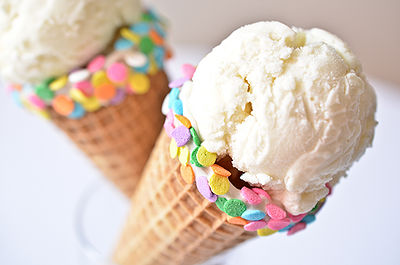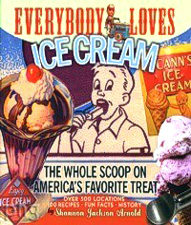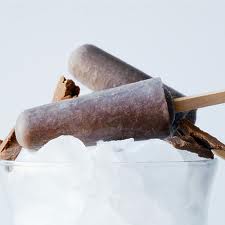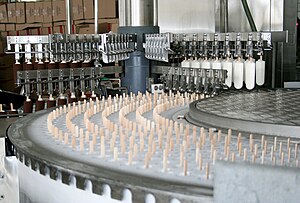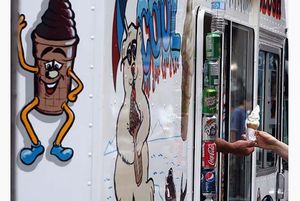Course:FNH200/2012w Team21 IceCream
Ice Cream
Introduction
- Ice cream is one of the most commonly eaten desserts all over the world. It is a frozen food made with dairy products, sweeteners and other unique ingredients to create a variety of flavours. Air is the single most important ingredient when making ice cream into a solid foam material. Air in combination with dairy products, sweeteners and other unique ingredients makes ice cream very soft and mellow, which readily melts in the mouth, instead of it being a chunk of hard ice. With the development of the production of ice cream, many ice cream companies have their own special recipes and technologies to manufacture various flavours of ice cream. People can either purchase ice cream products from distributors such as grocery stores and shops or make their own at home. The world of ice cream is quite large and is still growing. Therefore, the focus of this wiki page is the process from the initial raw ingredients of ice cream all the way to ice cream in the homes of consumers.
- The questions about ice cream investigated include:
- Where did ice cream come from?
- What are the standards of ice cream in Canada?
- How was ice cream traditionally made?
- What are the different types of ice creams?
- What ingredients make up ice cream?
- How is ice cream made commercially?
- How is ice cream transported for distribution?
- How must ice cream be stored?
- Let’s dive into the world of ice cream!
History
- It is still an unknown that who are credited for creating the first ice cream. Some people said that it was first made from Roman Emperor Nero. He sent people to the mountains to get snow and mix it with fruit toppings.[1] Some people said that it was first made from the Chinese Emperor of the Tang dynasty. The Chinese introduced a method of creating ice and mike concoction. Then this method was brought from China to Europe.[2]Some people said that it was Marco Polo, an explorer, brought the idea of ice cream with him while he was traveling to China.[3]
- Despite the origin of ice cream was a mystery, American opened the first ice cream parlor in New York City in 1776. The name, ice-cream, was originally called “iced-cream” that was similar to “iced tea’. Ice-cream was considered a luxury dessert. Famous people, such as George Washington and Thomas Jefferson, served ice-cream to their guests.[2]
- As technology progressed, the recipe, the method, and the flavor of ice cream were improved. For example, someone invented a method of mixing ice with salt in order to lower and control the temperature of ice cream. Also, someone invented a wooden bucket freezer with rotary paddles to improve ice cream’s manufacture.In World War II, ice cream became so popular in America and has become a symbol of American culture. Therefore, many people thought that ice cream was originally from America.[2]
- Today ice cream has become a very common dessert. It has also turned into various frozen desserts, such as ice cream sundae, gelato, and sorbet. An interesting note is that the largest consumer of ice cream is the United States and it is followed by Australia and New Zealand.[3]
Production
Standards of Ice Cream Product
- (standard of identity for ice cream mix)[4]
- The ice cream mix should be the unfrozen, pasteurized combination of cream, milk or other milk products, sweetened with sweeteners such as sugar, liquid sugar, invert sugar, honey, dextrose, glucose, corn syrup, corn syrup solids. It is allowed to contain the following substances:
- egg
- flavouring preparation
- cocoa or chocolate syrup
- food colouring
- pH adjusting agents
- microcrystalline cellulose or a stabilizing agent or both in an amount that will not exceed 0.5 per cent of the ice cream made from the mix
- sequestering agent
- salt
- added edible casein or edible caseinates ( not more than 1%)
- propylene glycol mono fatty acid esters ( not exceed 0.35 % of the ice cream made from the mix)
- sorbitan tristearate (not exceed 0.035% of the ice cream made from the mix)
- In order to be considered as ice cream, the product produced should not contain less than 38% solids and 10% milk fat or 8% milk fat (when cocoa or chocolate syrup is added).
Labelling Ice Cream
- In today’s market, there is a large variety of ice cream. This large variety sometimes confuses consumers when making decisions between brands or flavours of ice cream. There are commonly used nutrient claims that describe ice cream products in terms of their fat and calorie content. The FDA permits the use of of the following nutrient claims on the labels of the different types of ice cream:[5]
- Reduced fat- contains at least 25% less total fat than the regular product
- Light- contains at least 50% less total fat or 33% less calories than the regular product
- Low fat- contains a maximum of 3 grams of total fat per serving
- Non fat- contains less than 0.5 grams of total fat per serving
- Also, for ice cream, there are marketing claims that companies use to describe the quality of the ice cream. These quality claims are based on a variety of aspects such as price, ingredient quality, amount of overrun (air) in product...etc. The following marketing claims are permitted on the labels of ice cream: [6]
- Superpremium- tends to have very low overrun, high fat content and the best quality ingredients
- Premium- tends to have low overrun, high fat content than regular and high quality ingredients
- Regular- meets the overrun requirement set by the ice cream standard
- Economy- meets the overrun requirement set by the ice cream standard and sells for an inexpensive price
Traditional Method
- Before refrigeration, ice cream was a handmade luxury. The ingredients were mixed in a mixing bowl inside a tub filled with ice and salt water. The salt functions to help the ice absorb more heat and therefore cools the ice cream mixture to below freezing.
Types of Ice Cream
- There are 4 main types of ice cream:
- Moulded Ice Cream
- Moulded ice cream is ice cream or water ice mix that is filled into moulds and frozen to produce stick novelties. They are also known as popsicles, ice lollies, ice bars or ice poles and form the largest part of the retail ice cream product. [7]
- Filled Ice Cream
- Ice cream that is filled into different containers such as ( cups, bulks, tubs, cones, squeeze-ups..etc). All ice creams can be shaped into a unique product with an impressive combination of ripple, swirl of sauces and large inclusions. [8]
- Extruded Ice Cream
- Top quality ice cream, known as extruded ice cream, are often more viscous (stiffer and colder) and creamier than moulded or filled ice cream. Extruded ice cream is typically extruded onto a tray using a time-elapse filler. [9] A wide variety of products can be produced including stick novelties, sandwiches...etc and can be decorated or coated.
- Low Temperature Ice Cream
- Low temperature ice cream undergoes a cold kneading process creating a finely structured ice cream with a smoother feel and creamier taste. [10] One can achieve excellent creaminess even with low-fat ice cream products.
Main Ingredients
- The ingredients and recipes for ice cream can vary, but most ice creams made today include the following basic ingredients: [11]
- Milk Fat
- It is the single most important ingredient of ice cream. Milk fat provides creaminess and richness to ice cream. It also contributes to the melting characteristic. The sources of milk fat are milk, cream, and butter.
- Milk Solids (Non-Fat)
- Milk solids includes protein, lactose and ash. It provides body and texture by stabilizing air that is added during freezing. Milk solids contribute nutritional value such as protein, Calcium, vitamins and minerals. The sources of non-fat solids are milk, cream, condensed milk, evaporated milk, dry milk, and whey.
- Sweetneners
- Sweeteners provide sweetness and softness (can be easily scooped or eaten) by lowering the freezing point of the mix, so water is unfrozen at room temperature. Common sweeteners used are sucrose, corn syrups, cane or beet sugar and honey.
- Plant-Based Stabilizers
- Stabilizers are usually carbohydrates or proteins. They provide viscosity and control ice crystallization by preventing formation of large crystals that can deteriorate the texture of ice cream.
- Emulsifiers
- Emulsifiers provide smoothness and stabilizes air added by keeping milk fat evenly distributed throughout the ice cream during the whipping process. Common emulsifiers are lecithin in egg yolks, monoglycerides, and diglycerides.
- Flavouring
- Flavouring is added depending on the type of ice cream. It may include natural flavouring, artificial flavouring, fruits, candies, nuts...etc.
Basic Steps of Manufacturing Ice Cream Products
- Blending of Ice Cream Mix[12]
- Ice cream mix is made when the specific liquid and dry ingredients (milk fat source, nonfat solids, stabilizers, emulsifiers) are combined in a mixing tank. The type and amount of ingredients is dependent on the formulation and calculation of a recipe.
- Composition of ice cream mix: [13]
- milk fat: > 10% - 16%
- milk solids-not-fat (contains 38% protein, 54% lactose,8% ash) : 9% - 12%
- sucrose: 10% - 14%
- corn syrup solids: 4% - 5%
- stabilizers: 0% - 5%
- emulsifiers: 0% - 0.4%
- water: 55% - 64%
- The fresh cream is stored in refrigerated silos just few degrees above freezing. The silos is equipped with a high speed mixer that blends the cream with other ingredients. After about 3 minutes of mixing, the mixture is moved to pasteurization tank through a pumping system.
- Pasteurization[12]
- The main purpose of pasteurization is to destroy pathogenic microorganisms, prevents growth of spoilage-causing microorganisms and activating the stabilizers. There are 2 types of pasteurization:batch and continuous (HTST)
- 1. Batch Pasteurization
- Ingredients are mixed in jacketed vats; ice cream mix is heated to at least 69°C for at least 30 minutes or 80°C for 25 seconds using steam or hot water.
- 2. Continuous Pasteurization
- Ingredients are mixed in insulated feed tank; high temperature short time (HTST) heat exchanged used; sometimes preheating may be needed at 30-40°C for increasing solubility of the mix.
- 1. Batch Pasteurization
- The temperature-time combinations for pasteurization can vary, depending on a variety of details that range from the ice cream mix composition to the national pasteurization regulations. BC's Regulation for Pasteurization is 63°C (145°F) or hotter for at least 30 minutes.
- Homogenization[12]
- The main purpose of homogenization is to ensures a balanced dispersion of emulsifiers and stabilizer throughout the ice cream before freezing. It also reduces the size of the globule of the milk fat in ice cream to create a better emulsion. A pressure of 2000-2500 pounds per square must be used to break down the globules and create a better emulsion that makes the texture of ice cream smoother and creamier.
- Aging[12]
- Aging forces the ice cream to cool to about 5°C before actual freezing. It helps with the crystallization of the globules of milk fat and gives enough time for the hydration of the stabilizers.
- Addition of Liquid Flavouring and Colouring[12]
- Only liquid flavouring is added at this time, so the ice cream mixture retains a texture that can be easily mixed and moved in the ice cream making equipment during freezing.
- Freezing/Whipping[12]
- After flavouring process, the ice cream mix undergoes dynamic freezing process known as the continuous freezer method or batch freezer method, where a portion of water is frozen and air is incorporated into the mix by whipping. The continuous ice cream freezer is jacketed with ammonia or freon ( refrigerants). Inside the freezer, there is a rotating blade that dashes inside the machine to incorporate air into the mix, so the ice cream does not become solid. This method freezes one batch of ice cream consisting of a specific amount at a time.
- Addition of Bulky Flavouring[12]
- As the ice cream is drawn with about half of its water frozen, bulky flavourings such as fruits, nuts, candy, cookies...etc can be added to the semi-frozen slurry. The bulky flavourings are easily dropped or shot into the semi-frozen ice cream due to its easy-flowing consistency, similar to that of soft-serve ice cream.
- Filling
- 1. Moulded Ice Cream
- Eg. ice cream bar
- The moulds descend into a tank of brine where water is chilled to -35°C mixed with calcium. while the molds are floating in brine, the machine injects the ice cream mix into the mould. Once the ice cream reaches the semi frozen stage, sticks are inserted by the stick inserter. The ice cream then travels to a tank of warm water at 24°C to be detach from the mould. After detachment process, the ice cream bar is dipped in cold water to produce a protective coating of ice to keep the surface from sticking to the wrappers and lengthen the product’s shelf life. The machine then deposits the ice cream bars to a stream of continuous paper wrapping which is sealed by a heating element. the machine then cuts the in between the wraps to separate each ice cream bar.
- Eg. ice cream bar
- 2. Filled Ice Cream [14]
- Eg. ice cream cone
- A feeder drops pre-wrapped sugar cone into a holder on conveyor belt. A layer of chocolate is sprayed onto the inside of the cone to create a barrier between the ice cream and the cone so the cone remains crispy. Next, the nozzle injects the ice cream filling into the cone. The ice cream is then topped with liquid chocolate sauce and crumbled nuts by the machine. Finally the cones move under a lid dispenser that applies a waxed coated paper lid for each cone. A heating element instantly melts the wax, sealing the lid to the cone.
- Eg. ice cream cone
- 3. Low Temperature Ice Cream [14]
- Eg. ice cream sandwich
- A filling machine feeds two lines of wafers toward an injection pipe where 1/3 of a cup of ice cream mixture is injected. The pipe head shapes the ice cream into a rectangle which fits perfectly between the wafers. During the process of packaging, the filling is still ice cold from the freezing phase. The packaging system raises each sandwich to a wrapper then is folded and with their ends tucked. Another machine is used to insert the packaged individual sandwich to a box. Once the box is loaded, it is sealed and stored at -22°C.
- Eg. ice cream sandwich
- 1. Moulded Ice Cream
- Packaging
- Generally packaging of ice cream is done before hardening. Packaging materials used for ice cream must be resistant to the transfer of water vapour from the food to the dry environment within the freezing unit. It is desirable to have packaging material that can protect the product from temperature fluctuation within the freezing unit.
- There are two main types of ice cream packaging:
- 1. Multi Service (like ice cream shop)
- Tinned steel cans or stainless steel cans of different sizes and shapes are used. These cans are cleaned, sanitized and used repeatedly.[15]
- 2. Single Service
- These kind of packages are used and discarded. They are very popular for both bulk and retail sales.
- Ice cream for bulk sale is packaged in fibre-board cartons coated with wax or provided with plastic liners that range from 5-25 litres. Plastic cylindrical containers with lids are also used for bulk packaging the ice cream (especially the carry home packages).[15]
- Ice cream for retail sale is filled in small cups or cartons that may be made out of paper or card-board treated with wax or plastic.
- 1. Multi Service (like ice cream shop)
- Hardening
- Hardening is a continuation of freezing process. After the ice cream is packaged, it is in a semi frozen stage which is not stiff enough to hold its shape and thus freezing process is continued. [15] Rapid freezing is desired as it decreases the formation of larger ice crystals that destroys the smooth texture of ice cream. There are three fast hardening methods:
- 1. Hardening Room
- Large storing space maintained at -30°C or lower. Cold air circulation is well maintained to ensure uniform cooling effect.
- 2. Hardening Tunnel
- An insulated tunnel through which large volume of air is discharged. The air circulating the tunnel is kept at -35 to -40°C. It is preferred by manufacturers with large volume production of ice cream products.
- 3. Hardening Cabinet
- A small, refrigerated storing and hardening cabinet maintained at –25°C or below. It is only useful when the volume of operation is low.
- 1. Hardening Room
Major Brands
- Haagendaz
- Chapman’s
- Nestle
- Dreyers ( subsidiary brand of Nestle)
- Ben & Jerry’s
Storage Requirements and Transportation
- Ice cream can be mass produced in factories and distributed around the world. They are often sold in large quantity cartons from supermarkets or in smaller individual packages in ice cream shops or convenience stores. In many countries in the world, ice cream is also sold from vehicles with refrigeration, such as motorcycles or vans (i.e. ice cream trucks). [16]
- There are five distribution centers of ice cream in Canada, three of which are owned by Nestlé and two of which are run by a third-party logistics provider Versacold. [17]Nestlé is a very important contributor to the ice cream industry, being responsible for popular products such as Parlour, Haagen-Dazs, Real Dairy, and Drumstick and Dibs. Nestlé by itself makes over 500,000 deliveries each year, which are mostly for transportation of products to stores. Establishments that are registered by the Canadian government for ice cream production must been specific requirements that are written in the Dairy Industry Act. The premises and manufacturing equipment must be kept clean and in good sanitary conditions.
- Ice cream is very delicate, and deterioration can easily affect flavor and texture. It is important that during storage and transportation, the correct storage requirements are met constantly in order to prevent damage from pressure, temperature, odours, etc. Ice cream must be stored at temperatures below -18 Celsius throughout storage, transportation, and display, and is kept in the ideal temperature of -25 degrees Celsius. Vehicles with highly sophisticated refrigeration units are used to transport ice cream and maintain its quality. Because of its almost neutral pH and high nutritional value, ice cream can be susceptible to growth of microorganisms. Although pasteurization eliminates most pathogenic microorganisms that pose risks to public health, other microorganisms may be introduced during production processes following pasteurization. It is important to note that many microorganisms, such as Salmonella spp., Listeria monocytogenes, Campylobacter spp. and Yersinia spp, can survive in very low temperatures. [18]
Process/ Hazards / Control Measures
- All steps in the production process from handling of the raw materials to the final storage and transportation must be heavily controlled, as microorganisms and pathogens may be introduced or recontaminated in every step of the production process.
- In the past, there have been some cases of high levels of bacteria found in ice cream products. For example, WKYC article from Ohio states that high levels of coliform bacteria have been found at two ice cream stands. [19] This bacteria can cause nausea, diarrhea, vomiting and headaches when high levels are consumed. When randomly selected ice cream locations were tested, 2 out of the 15 locations indicated high levels of this bacteria in their ice cream. Similarly, an online article by TheStar describes a comparable incident in Canada. [20] 14 locations serving soft ice cream and frozen yogurt (including mobile trucks, street kiosks, and retail chains) have been tested across Toronto, and the results showed that 5 of the vendors exceeded limits of coliform bacterial content. The city’s medical officer of health has stated that this level of bacteria may be caused by improper sanitation or refrigeration. Canadian guidelines strictly limit the amount of coliform bacteria to 10 organisms per gram of the product, and the highest level of bacteria found during the investigation was 3,000 organisms. In both cases, high levels of bacteria were found despite the fact that the ice cream machines were thoroughly washed and sanitized daily.
Video - Interviews at UBC Student Union Building
Interviewed on March 8, 2013
Interesting Facts
- Favourite Ice Cream Flavours [21]
- (Flavor, percent favoring)
- 1. Vanilla, 29%
- 2. Chocolate, 8.9%
- 3. Butter pecan, 5.3%
- 4. Strawberry, 5.3%
- 5. Neapolitan, 4.2%
- 6. Chocolate chip, 3.9%
- 7. French vanilla, 3.8%
- 8. Cookies and cream, 3.6%
- 9. Vanilla fudge ripple, 2.6%
- 10. Praline pecan, 1.7%
- 11. Cherry, 1.6%
- 12. Chocolate almond, 1.6%
- 13. Coffee, 1.6%
- 14. Rocky road, 1.5%
- 15. Chocolate marshmallow, 1.3%
- 16. All others, 23.7%
- Largest Ice Cream Consumer [22]
- The largest consumer of ice cream in the entire world are Americans. They consumed 35.9 pints of ice cream in 2011. The second largest consumer of ice cream are Australians who consumed 21.8 pints of ice cream in 2011.
- 100% Canadian Milk Logo [23]
- The Dairy Farmers of Canada created a logo to authenticate dairy products made exclusively from 100% Canadian milk, which may include ingredients derived from milk.
- Ice Cream Month [24]
- The International Ice Cream Association (IICA) encourages consumers to celebrate July as National Ice Cream Month. National Ice Cream Day is always the third Sunday of July. This year, National Ice Cream Day falls on Sunday, July 21, 2013.
- Largest Ice Cream Sundae [25]
- In 1988, the largest ice cream sundae was made by Palm Daries Ltd. in Alberta, Canada. It weighed 54,914 pounds.
- One Ice Cream Scoop [26]
- To finish one scoop of ice cream, it takes about 50 licks.
- 10 Ice Cream Shops in Vancouver [27]
- 1. La Casa Gelato International: 1033 Venables Street, Vancouver
- 2. Bella Gelateria: 1001 West Cordova, Vancouver
- 3. Marble Slab: 1184 Denman, Vancouver
- 4. Gelormy Formerly Mondo Gelato: 1094 Denman St, Vancouver
- 5. 7 Sweet Sins: 683 Abbott St., Vancouver
- 6. Mario’s Gelati: 88 East 1st Avenue, Vancouver
- 7. Dolce Amore Gelateria: 1588 Commercial Drive, Vancouver
- 8. Scoop!: 2050 West 4th Ave, Vancouver
- 9. Yaletown Gelato: 1208 Homer Street, Vancouver
- 10. Bellagio’s Gelato: 3075 Main Street, Vancouver
Conclusion
- Ice cream dates all the way back to 1744. [28]. The popularity of ice cream increased dramatically around the world when ice production first became common. Today, ice cream continues to be one of the most popular desserts of people from right here in Canada all the way to other side of the world in Australia. However, the process of making ice cream from the raw ingredients to bringing ice cream to our homes requires specific procedural steps. Any alteration or mistake in this process can result in the loss of the ice cream identity for the food product. The world of ice cream will continue to grow and develop in the future, while still bringing smiles on people’s faces as they indulge their craving for ice cream.
Final Exam Question
Question:
Pick three of the six main ingredients of ice cream and explain what roles do they play in the the production of ice cream.
Answer: (Pick three of six)
- Milk fat – provide creaminess, richness and melting characteristic of ice cream
- Milk solid – stabilize air during freezing to give body and texture and also provide nutritional value of ice cream
- Sweetners – lower the freezing point of the mix to give sweetness and softness
- Plant-Based stabilizes – prevent formation of large crystals to provide viscosity and control of ice crystallization
- Emulsifiers – keep milk fat evenly distributed throughout the ice cream during whipping to provide smoothness and stabilization of added air
- Flavouring – include natural and artificial flavourings to provide different flavours of ice cream
References
References:
- ↑ Hale, J. D. (2004). The history of ice cream: who invented it. The Old Farmer's Almanac. Retrieved from http://www.almanac.com/content/history-ice-cream-who-invented-it
- ↑ 2.0 2.1 2.2 Bellis, M. (n.d.). History of ice cream. Retrieved from http://inventors.about.com/od/foodrelatedinventions/a/ice_cream.htm
- ↑ 3.0 3.1 Cultural China. (n.d.). The origins and history of ice cream. Retrieved from http://history.cultural-china.com/en/182History5909.html
- ↑ Canadian Food and Drugs Act.http://laws.justice.gc.ca/eng/regulations/C.R.C.,_c._870/page-111.html#h-78
- ↑ Roeder, Jeannette. (n.d.). Ice Cream Labelling. International Dairy Foods Association. Retrieved from http://homecooking.about.com/od/foodhistory/a/icecreamhistory.htm
- ↑ Roeder, Jeannette. (n.d.). Ice Cream Labelling. International Dairy Foods Association. Retrieved from http://homecooking.about.com/od/foodhistory/a/icecreamhistory.htm
- ↑ Tetra Pak. (n.d.). Moulded ice cream. Retrieved from http://www.tetrapak.com/food_categories/ice_cream/moulded_ice_cream/pages/default.aspx
- ↑ Tetra Pak. (n.d.). Filled ice cream. Retrieved from http://www.tetrapak.com/food_categories/ice_cream/filled_ice_cream/pages/default.aspx
- ↑ Tetra Pak. (n.d.).Extruded ice cream. Retrieved from http://www.tetrapak.com/food_categories/ice_cream/extruded_ice_cream/pages/default.aspx
- ↑ Tetra Pak. (n.d.). Low temperature ice cream. Retrieved from http://www.tetrapak.com/food_categories/ice_cream/low_temp_ice_cream/pages/default.aspx
- ↑ No author. (n.d.) Ice Cream Production- Ingredients. Milk Facts. Retrieved from http://www.milkfacts.info/Milk%20Processing/Ice%20Cream%20Production.htm
- ↑ 12.0 12.1 12.2 12.3 12.4 12.5 12.6 Goff, H. D. (n.d.). Dairy Science and Technology. Retrieved from http://www.uoguelph.ca/foodscience/dairy-science-and-technology
- ↑ Goff, H. D. (n.d.). Ice Cream Mix Ingredients. University of Guelph Food Science. Retrieved from http://www.uoguelph.ca/foodscience/dairy-science-and-technology/dairy-products/ice-cream/ice-cream-ingredients
- ↑ 14.0 14.1 How it is made: Ice cream treats. [video file] Retrieved from https://www.youtube.com/watch?v=fWon4ITqago&feature=player_embedded
- ↑ 15.0 15.1 15.2 (2011). Frozen desserts. Retrieved from http://vedyadhara.ignou.ac.in/wiki/images/0/0a/BPVI-16-Block_3-Unit-10.pdf
- ↑ (2011). Ice Cream. Retrieved from http://en.wikipedia.org/wiki/Ice_cream#Production
- ↑ Deborah Aarts. (2011). Cold Chain Change. Retrieved from http://www.canadianmanufacturing.com/distribution-and-transportation/news/cold-chain-change-2-7581
- ↑ Food and Environmental Hygiene Department HKSAR. (2011). Microbiological Risk Assessment of Ice Cream. Retrieved from http://www.cfs.gov.hk/english/programme/programme_rafs/files/ice_e.pdf
- ↑ Tom Meyer. (2011). Investigator: High Bacteria Levels found in Ice Cream. Retrieved from http://www.wkyc.com/news/investigative/article/198163/230/Investigator-High-bacteria-levels-found-in-ice-cream
- ↑ Diana Zlomislic. (2011). High levels of bacteria found in ice cream. Retrieved from http://www.thestar.com/life/health_wellness/2009/06/20/high_levels_of_bacteria_found_in_ice_cream.html
- ↑ The Food Channel.(2008). The Top 15 Most Popular Ice Cream Flavors. Retrieved from http://www.foodchannel.com/articles/article/the-top-15-most-popular-ice-cream-flavors/
- ↑ Covello, Lauren. (2011). The 5 Countries That Eat the Most Ice Cream. Fox Business. Retrieved from http://www.foxbusiness.com/personal-finance/slideshow/2012/09/26/5-countries-that-eat-most-ice/#slide=1
- ↑ Dairy Goodness. (n.d.) About The 100% Canadian Milk Symbol. Dairy Goodness. Retrieved from http://www.dairygoodness.ca/100-percent-canadian-milk/about-the-100-percent-canadian-milk-symbol
- ↑ IDFA. (n.d.). July is National Ice Cream Month. Retrieved from http://www.idfa.org/news--views/media-kits/ice-cream/july-is-national-ice-cream-mon/
- ↑ Khao. (2011). Learn some fun facts about ice cream. Retrieved from http://www.ifood.tv/blog/learn-some-fun-facts-about-ice-cream#sgiZ7pFo1cLWh5CI.99
- ↑ Cooks United. (2010). Fascinating Facts about Ice Cream. Cooksunited.co.uk. Retrieved from http://www.cooksunited.co.uk/magazine/article/16,2/CooksUnited.co.uk/Fascinating-Facts-about-Ice-Cream.html
- ↑ Vancity Buzz. (2011). Top Ten Ice Cream Shops in Vancouver. Vancity Buzz. Retrieved from http://www.vancitybuzz.com/2011/07/ice-cream-shops-vancouver/
- ↑ Filippone, Peggy Trowbridge. (2007). Ice Cream History. About.com. Retrieved from http://homecooking.about.com/od/foodhistory/a/icecreamhistory.htm
